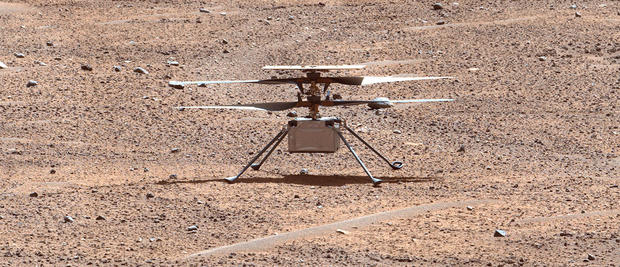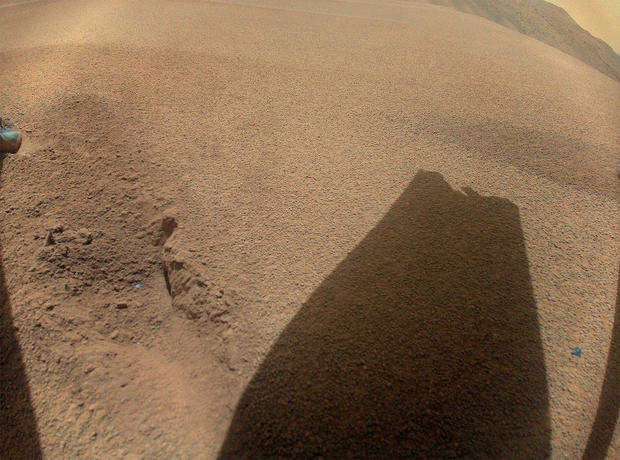NASA's Mars helicopter, first to fly on another world, ends marathon mission with rotor damage
Designed to fly just five times over 30 days, NASA's Ingenuity helicopter lasted nearly three years, soaring across the surface of Mars and logging 72 flights before a hard or tilted landing that damaged one or more rotors forced flight controllers to finally bring the marathon mission to a close.
Just as the Wright brothers "unlocked the skies on Earth...we all truly believe that Ingenuity has done the same for Mars, and we couldn't be prouder of our little, tough trailblazer," Teddy Tzanetos, Ingenuity project manager at NASA's Jet Propulsion Laboratory in Pasadena, California, said Thursday.
"While Ingenuity is not going to fly again, new generations of Mars helicopters are on the drawing board, and we're excited for what the future will hold in the skies of Mars."
Tipping the scales at just 4 pounds, Ingenuity was built at JPL and carried to Mars attached to the belly of NASA's Perseverance rover, which landed on the Red Planet on Feb. 18, 2021. To keep costs down, the solar-powered helicopter was built with mostly off-the-shelf components.
Shortly after the rover's landing on the floor of Jezero Crater, the helicopter was dropped to the surface and on April 19, 2021, it lifted off on the first of five planned test flights to demonstrate the feasibility of flying in the thin Martian atmosphere.
On Earth, helicopters typically can't generate enough lift to fly above about 25,000 feet, said JPL Director Laurie Leshin. On Mars, she said, the atmosphere is roughly equivalent to an altitude of 80,000 to 90,000 feet on Earth.
Citing a tongue-in-cheek engineering maxim, Leshin said Ingenuity went through the "three phases of a bold idea."
"First, it's ridiculed. Second, it's violently opposed. And third, it's accepted as being self-evident," she said. "And in this case, the bold idea was that we could fly a helicopter on Mars ... where nobody thought it was possible."
The mission requirement called for just five flights, but engineers held out hope the small drone would exceed expectations, and it did just that. After its seventh flight, NASA began using it as a scout for Perseverance, flying ahead and relaying imagery of upcoming routes to mission planners at JPL.
And so, for weeks, then months, and finally nearly three years, Ingenuity soldiered on, making repeated trips above the floor of Jezero Crater where Perseverance is looking for signs of past habitability, and storing rock and soil samples for eventual return to Earth.
But on Jan. 18, shortly after Ingenuity made an emergency landing at the end of its 71st flight, controllers sent commands to carry out a short vertical flight to help determine its precise location in relatively featureless terrain.
That terrain, with few surface landmarks, may have confused Ingenuity's flight computer and prompted it to bring flight 71 to a quick conclusion, and to then stand by for instructions from Earth.
In any case, the helicopter took off on flight 72 as planned, reaching an altitude of 40 feet. It hovered for 4.5 seconds and then began its descent.
But at an altitude of 3 feet or so, Ingenuity dropped out of contact with flight controllers. Communications were restored the next day, and imagery reaching Earth a few days later showed that at least one of its high-speed rotors was damaged, presumably due to an off-kilter landing.
The outer 25% to 35% of a helicopter's rotors generate the lion's share of the lift, and the blades must be balanced with high precision to avoid catastrophic vibrations. A photo showing the shadow of one rotor revealed its tip had been torn away, presumably by impact with the Martian surface.
"Because we think we've lost about 25% of one of the blades, that means we've just lost a massive chunk of our thrust capacity," Tzanetos told reporters. Even if the blades were somehow perfectly balanced despite the damage, Ingenuity's ability to precisely control roll and pitch would be compromised.
"So all of that leads us to believe that we will not be able to fly anymore," Tzanetos said.
Thursday night marked 1,000 slightly longer Martian days, or sols, since Ingenuity was dropped onto the Red Planet's surface. Engineers remain in radio contact and may try to briefly spin the blades to get a better view of the rotors. But eventually, as Perseverance continues its exploration and moves farther and farther away, contact will be lost.
With an unexpectedly long mission like Ingenuity's "there's always that piece in the back you're head, you know, today could be the last day," Tzanetos said. "...So that was the initial moment, obviously, of sadness, seeing that photo come down and pop on screen.
"But that's very quickly replaced with happiness and a feeling of celebration for what we pulled off. It's really remarkable the journey that she's been on and worth celebrating every single one of those sols."





